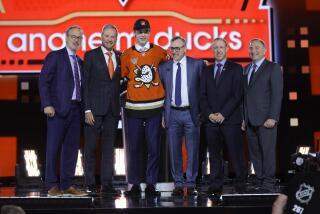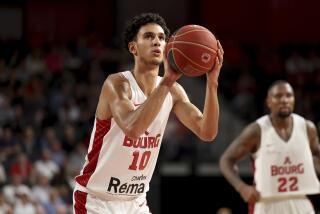Jets Seek an Impact Player With 15th Pick
- Share via
HEMPSTEAD, N.Y. — Dick Steinberg looks at his draft board and sees “a dozen really good players” on top. That’s exciting, yet a little frustrating for the New York Jets’ general manager.
Exciting, because it’s a portent of the quality in this year’s National Football League draft, which begins Sunday. Frustrating, because the Jets pick 15th, which means they are “below the upper-echelon group, so we’ll have to get lucky to have one of those players drop down to us,” Steinberg said.
Typical Jets. They know all about coming close. (See last season’s “red zone” failures.)
But, hey, it’s not that bad. Not at all. Even if they don’t get “lucky,” and miss out on one of their desirable dozen, the Jets still should get a fine player in the first round. The second round, too. And the third.
The experts are calling this a deep draft that is particularly strong on defense. This is good news for the Jets, an 8-8 team that has a few more holes to fill before it can challenge the Buffalo Bills in the American Football Conference East.
“I would hope to do real well this year, because we have all our choices and it looks like a pretty good draft,” said Steinberg, preparing for his third draft as the Jets’ football boss.
Steinberg’s first-round wish is defense -- preferably a lineman or linebacker -- but, as always, an early run on defensive players is expected. The top defenders on the Jets’ board -- Washington defensive tackle Steve Emtman, Pittsburgh defensive end Sean Gilbert, Texas A&M; linebacker Quentin Coryatt, Wisconsin cornerback Troy Vincent and Florida State cornerback Terrell Buckley -- will be long gone. Too bad, because the Jets still do not have an impact player on defense.
The upside for the Jets is that, with the premier defenders off the board, they will get to choose from an appealing group of offensive players. Assuming Michigan wide receiver Desmond Howard, Stanford left tackle Bob Whitfield, Houston quarterback David Klingler and Miami left tackle Leon Searcy are taken, the Jets could be left to choose from Notre Dame tight end Derek Brown, Virginia left tackle Ray Roberts, Virginia Tech left tackle Eugene Chung, Indiana running back Vaughn Dunbar and Stanford fullback Tommy Vardell.
Steinberg would love to get Brown, an athletic tight end who would fill a major void, but there is a chance he will be gone, too. An intriguing alternative would be Roberts (6-foot-5 1/2, 304 pounds), who has the size and athletic ability to be a fixture at left tackle.
The Jets certainly could use another tackle. Jeff Criswell, the starter on the left since 1988, is adequate at best. Right tackle Irv Eatman is coming off a good year, but he’s 31. The only reserve is 33-year-old Brett Miller. Solidifying the left-tackle spot -- a crucial position because he protects the quarterback’s blind side -- would be a major step toward improving the overall offense. “Our line is decent ... but we’d definitely like to get a dominating-type guy,” Steinberg said after the season. “That could be the direction we go.”
Would Steinberg throw a changeup and select a running back? Hmmm. What if Dunbar unexpectedly slips to the Jets? He likes Dunbar (“A good back, very productive”) and raves about Vardell.
The Jets have a good fullback in Brad Baxter. Otherwise, they have Blair Thomas, a disappointment so far, and two older backs, Freeman McNeil (33) and Johnny Hector (31). “If a back is there, we wouldn’t walk around him,” said Steinberg, always preaching his best-available-athlete credo.
Who knows, maybe the Jets will get a defensive player in Round 1. If so, it likely would be Texas A&M; cornerback Kevin Smith or South Carolina State defensive tackle Robert Porcher or Michigan State defensive tackle Bill Johnson. Ohio State defensive end Alonzo Spellman and-or Clemson defensive tackle Chester McGlockton could be available -- both are terrific athletes -- but the Jets have concerns about their productivity.
Ideally, the Jets would like an outside linebacker to challenge Joe Kelly, but there isn’t much first-round talent after Coryatt. Look for them to address the need in the second or third round.
The defensive line is another need area. The Jets have a decent line, but they lack a dangerous pass rusher and an enforcer against the run. Johnson (6-4, 307) and Porcher (6-4, 283), both inside players, are first-round possibilities, but Steinberg hinted he may wait until the later rounds to select a lineman.
“There’s quite a dropoff after (Emtman and Gilbert),” he said. Steinberg could be blowing smoke, which NFL executives have been known to do at draft time.
When the smoke clears, the Jets’ draft may include two or three first-year starters, plus two or three other contributors. They need bodies, which is why Steinberg isn’t likely to trade up in the first round. “If we have to give up a (second-round pick) to move up three or four spots, it leaves a big hole in our draft, and we’d like to come out of this with help at several positions,” he said.
And they will need it to keep pace with their division rivals. The Indianapolis Colts own the Nos. 1 and 2 picks, the Miami Dolphins Nos. 7 and 12 and the New England Patriots No. 8. That, combined with a much tougher schedule in 1992, makes it imperative the Jets score big Sunday and Monday.
“There is no five-year plan,” Steinberg said. “We know we have to make progress.”
More to Read
Go beyond the scoreboard
Get the latest on L.A.'s teams in the daily Sports Report newsletter.
You may occasionally receive promotional content from the Los Angeles Times.










